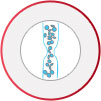Pulmonary Embolism (PE)
Pulmonary embolism is a medical condition where one or more blood clots block the supply of blood to the lungs. The blood clot can form in the veins in the legs, pelvis or abdomen and then dislodge and travel in the blood stream to wedge in the arteries supplying the lungs. Pulmonary embolism is a potentially life-threatening and serious condition requiring immediate medical intervention. The seriousness of the condition varies with the size of the blood clot. Early diagnosis and treatment is hence critical to improve survival and reduce short term and long term complications.
What are the risk factors for PE?
As pulmonary embolism is directly related to deep vein thrombosis (DVT), factors that increase the chances of developing DVT also increase the risk of a pulmonary embolism. Some of these risk factors are
- Prolonged periods of inactivity such as hospital stay or recovery from surgery, sitting for a long time during travels such as by car or plane
- Certain medical conditions including cancers, pregnancy, obesity and heart failure
- Medications such as oral contraceptive pills and hormone replacement therapy
- Previous history of DVT or family history of DVT
- Certain blood disorders which make the blood thick and likely to clot easier
Symptoms and Diagnosis of PE
Symptoms
Some of the common symptoms of pulmonary embolism are sharp chest pain radiating towards your shoulder or neck, shortness of breath, cough, sweating, dizziness, anxiety, palpitations, fainting and light-headedness. However, sometimes a minor PE may go totally unnoticed with no symptoms.
Diagnosis
Your specialist will take a history of your symptoms, past medical history and conduct a thorough physical examination. You will be referred for specific investigations to confirm or exclude the diagnosis of a PE. Some of the common investigations are a chest X-ray, ECG, CT Pulmonary angiography (to determine the extent of PE) and an ultrasound of the legs (to exclude a DVT).
What are the treatment options?
The treatment strategies aim to address both the pulmonary embolism (PE) and also the causative deep vein thrombosis (DVT) although DVT may not be detected in all cases of PE. Treatment is started immediately after diagnosis of pulmonary embolism to avoid any risk or complications. In hospital, Oxygen is delivered via a nasal prong or mask and a cannula will be sited in the vein to ensure easy access to administer any medications directly into the blood stream. The treatment plan will depend on the severity of the PE. The options include:
-

Anticoagulation
- Your doctor will recommend anticoagulant medication for thinning the blood. This will be in the form of injections initially for immediate effect and subsequently in tablet form. Anticoagulants have been shown to prevent recurrent symptoms and early death. They prevent the formation of new clots and may also help dissolve clots that are already formed. In the vast majority of patients, anticoagulation may be the only treatment required for PE.
-

Thrombolysis
- This treatment is reserved for patients with life threatening Pulmonary embolism. Thrombolytic agents are potent medications that can breakdown clot and can be a valuable treatment option. Unfortunately, they can also pose a significant risk of life threatening bleeding and hence their use is reserved for patients with major PE (sustained shock with very low blood pressure and dysfunction of the heart) Thrombolytic agents can be administered either as a drip which is the more common practice and in some occasions via a catheter (narrow tube) introduced via the groin and manoeuvred to the site of the clot in the lungs. Certain sophisticated instruments which can mechanically break up the clot and suck the clot can also be introduced via this catheter as a life-saving procedure in dire situations.
-

IVC Filters
- Some patients with pulmonary embolism may not be suitable for anti-coagulation due other risk factors such as recent major surgery, adverse reactions to anticoagulants, major bleeding risks or conditions suc as pregnancy. These patients may be better suited for an Inferior Vena Caval (IVC) filter. Inferior vena cava is a large vein in the abdomen and chest that returns blood from the lower limbs and vital organs to the heart. This vein also has the potential to carry clots from the lower limbs and organs to the lungs. As the name suggests, IVC filter acts like a sieve which prevents large clots from travelling up the IVC into the lungs. However, IVC filter is not without complications and other risks and hence your doctor will discuss the pros and cons of this procedure in detail.
How can Pulmonary embolism be prevented?
Prevention of pulmonary embolism starts with prevention of DVT. This in-turn can be achieved by addressing the risk factors for DVT as discussed earlier. In-addition, strict adherence to the anticoagulation regime is very important in patients with previous history of pulmonary embolism.
